
A nursery rhyme is a traditional poem or song for children in Britain and other European countries, but usage of the term dates only from the late 18th/early 19th century. The term Mother Goose rhymes is interchangeable with nursery rhymes.

The John Newbery Medal, frequently shortened to the Newbery, is a literary award given by the Association for Library Service to Children (ALSC), a division of the American Library Association (ALA), to the author of "the most distinguished contributions to American literature for children". The Newbery and the Caldecott Medal are considered the two most prestigious awards for children's literature in the United States. Books selected are widely carried by bookstores and libraries, the authors are interviewed on television, and master's theses and doctoral dissertations are written on them. Named for John Newbery, an 18th-century English publisher of juvenile books, the winner of the Newbery is selected at the ALA's Midwinter Conference by a fifteen-person committee. The Newbery was proposed by Frederic G. Melcher in 1921, making it the first children's book award in the world. The physical bronze medal was designed by Rene Paul Chambellan and is given to the winning author at the next ALA annual conference. Since its founding there have been several changes to the composition of the selection committee, while the physical medal remains the same.
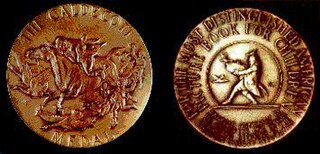
The Randolph Caldecott Medal, frequently shortened to just the Caldecott, annually recognizes the preceding year's "most distinguished American picture book for children". It is awarded to the illustrator by the Association for Library Service to Children (ALSC), a division of the American Library Association (ALA). The Caldecott and Newbery Medals are considered the most prestigious American children's book awards. Besides the Caldecott Medal, the committee awards a variable number of citations to runners-up they deem worthy, called the Caldecott Honor or Caldecott Honor Books.

Randolph Caldecott was a British artist and illustrator, born in Chester. The Caldecott Medal was named in his honour. He exercised his art chiefly in book illustrations. His abilities as an artist were promptly and generously recognised by the Royal Academy. Caldecott greatly influenced illustration of children's books during the nineteenth century. Two books illustrated by him, priced at a shilling each, were published every Christmas for eight years.

Drummer Hoff is an illustrated children's book by Barbara and Ed Emberley. Ed Emberley won the 1968 Caldecott Medal for the book's illustrations. Written by Barbara Emberley, it tells a cumulative tale of seven soldiers who build a cannon named "Sultan", and Drummer Hoff, who fires it off, with the book exploding into a blast of colors. The last picture shows the exploded cannon at a future point in time among wildflowers and birds. The illustrations, done in woodcuts, evoke both 1960s psychedelica and Colonial American engravings. In 1969, the book was adapted into an animated 6 minute theatrical short, directed by Gene Deitch and produced by Morton Schindel of Weston Woods Studios. It was released on DVD in 2008.

Marguerite de Angeli was an American writer and illustrator of children's books including the 1950 Newbery Award winning book The Door in the Wall. She wrote and illustrated twenty-eight of her own books, and illustrated more than three dozen books and numerous magazine stories and articles for other authors.
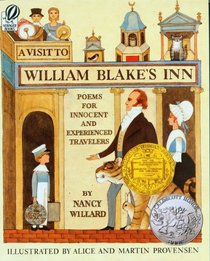
A Visit to William Blake's Inn: Poems for Innocent and Experienced Travelers is a children's picture book written by Nancy Willard and illustrated by Alice and Martin Provensen, published by Harcourt Brace in 1981. The next year Willard won the annual Newbery Medal and the Provensens were one runner-up for the Caldecott Medal from the professional children's librarians. William Blake's Inn was the first Newbery-winning book to also be named a Caldecott Honor Book. Last Stop on Market Street later won the 2016 Newbery Medal and a Caldecott Honor.

Chris Raschka is an American illustrator, writer, and violist. He contributed to children's literature as a children's illustrator.
Margot Zemach was an American illustrator of more than forty children's books, some of which she also wrote. Many were adaptations of folk tales from around the world, especially Yiddish and other Eastern European stories. She and her husband Harvey Fischtrom, writing as Harve Zemach, collaborated on several picture books including Duffy and the Devil for which she won the 1974 Caldecott Medal.

The Rooster Crows: A Book of American Rhymes and Jingles, written and illustrated by Maud and Miska Petersham, is a 1945 picture book published by Simon & Schuster. The Rooster Crows was a Caldecott Medal winner for illustration in 1946. This book is a collection of traditional American nursery rhymes, finger games, skipping rhymes, jingles, and counting-out rhymes. They come from collections all over America.

The Three Pigs is a children's picture book that was written and illustrated by David Wiesner. Published in 2001 by Houghton Mifflin/Clarion, the book is based on the traditional tale of the Three Little Pigs, though in this story they step out of their own tale and wander into others, depicted in different illustration styles. Wiesner won the 2002 Caldecott Medal for his illustrations, Wiesner's second of three such medals.
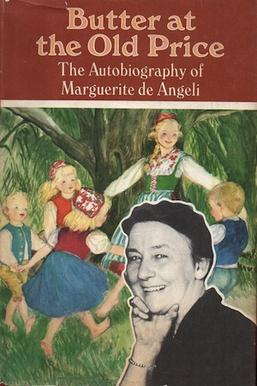
Butter at the Old Price: The Autobiography of Marguerite de Angeli is an account of the life and work of the children's author and illustrator Marguerite de Angeli, who wrote such books as The Door in the Wall, Ted and Nina Go to the Grocery Store, Henner's Lydia, and Black Fox of Lorne. The autobiography was printed in 1971 by Doubleday Books when its author was 82 years old. Her 1946 story Bright April was the first children's book to address the divisive issue of racial prejudice. She was recipient of the 1950 Newbery Award for The Door in the Wall and was twice named a Caldecott Honor Book illustrator, first in 1945 for Yonie Wondernose and again in 1955 for Book of Nursery and Mother Goose Rhymes. She received a 1957 Newbery Honor mention for Black Fox of Lorne, a 1961 Lewis Carroll Shelf Award, and the 1968 Regina Medal.

The House in the Night is a children's picture book written by Susan Marie Swanson and illustrated by Beth Krommes. Published in 2008, the book is a bedtime verse about the light in a house during the night. Krommes won the 2009 Caldecott Medal for her illustrations.

Toy books were illustrated children's books that became popular in England's Victorian era. The earliest toy books were typically paperbound, with six illustrated pages and sold for sixpence; larger and more elaborate editions became popular later in the century. In the mid-19th century picture books began to be made for children, with illustrations dominating the text rather than supplementing the text.

Mother Goose is a 1944 picture book by Tasha Tudor. Tudor illustrated 76 Mother Goose nursery rhymes. The book was a recipient of a 1945 Caldecott Honor for its illustrations.
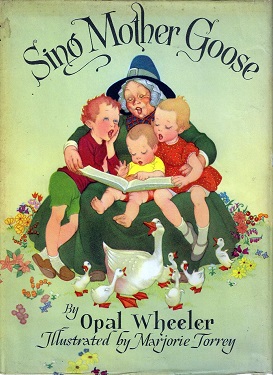
Sing Mother Goose is a 1945 picture book with music by Opal Wheeler and illustrated by Marjorie Torrey. The book contains a collection of Mother Goose Nursery rhymes set to music. The book was a recipient of a 1946 Caldecott Honor for its illustrations.

All Around the Town is a 1948 picture book written by Phyllis McGinley and illustrated by Helen Stone. The book is a rhyming alphabet book exploring a town. The book was a recipient of a 1949 Caldecott Honor for its illustrations.
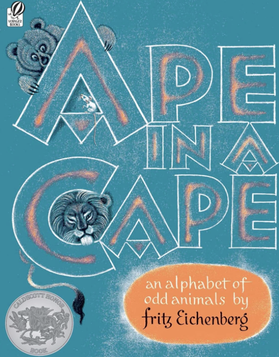
Ape in a Cape: An Alphabet of Odd Animals is a 1952 children's picture book written and illustrated by Fritz Eichenberg. The book is a rhyming alphabet book. The book was a recipient of a 1953 Caldecott Honor for its illustrations.

Book of Nursery and Mother Goose Rhymes is a 1954 picture book written and illustrated by Marguerite de Angeli. The book is a collection of Mother Goose rhymes accompanied by illustrations. The book was a recipient of a 1955 Caldecott Honor for its illustrations.
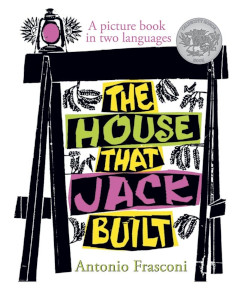
The House That Jack Built: La Maison Que Jacques A Batie is a 1958 picture book written and illustrated by Antonio Frasconi. The book tells the story of the nursery rhyme "This Is the House That Jack Built" in English and French. The book was a recipient of a 1959 Caldecott Honor for its illustrations.



















